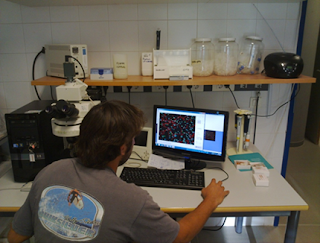Subjective and
objective assessment of fish sperm motility: when the technique and technicians
matter
V. Gallego, J.G. Herranz-Jusdado, C. Rozenfeld, L. Pérez,
J.F. Asturiano
Fish Physiology and Biochemistry, 44(6): 1457-1467. 2018
Fish Physiology and Biochemistry, 44(6): 1457-1467. 2018
Abstract
Fish sperm motility is nowadays considered the best sperm
quality biomarker in fish, and can be evaluated both by subjective and computerized
methods. With the aim to compare the precision and accuracy of both techniques,
fish sperm samples were assessed by subjective methods and by a computer
assisted sperm analysis (CASA-Mot) system,
and simultaneously by three different technicians with different degree of
expertise on the sperm quality analysis. Statistical dispersion parameters (CV,
coefficient of variation; and RG, range) were estimated in order to determine
the precision and accuracy of the techniques and the influence of laboratory
staff on sperm motion assessments.
Concerning precision, there were not much significant
differences between the technical support staff (high, medium, and low
experimented technician), and statistical dispersion parameters were quite
similar between them independently of the technique used and the sperm motility
class analyzed. However, concerning accuracy, experimented technician reported subjective
motility values very closed to the values provided by the CASA-Mot
system, only 10 percentage points away from
the data provided by a CASA-Mot system. However, medium and low-experimented
technicians often overestimate the CASA-Mot values, and amplitudes up to 30 percentage
points were detected in several sperm assessments.
To sum up, both the technique (subjective or objective)
and the technician (degree of expertise) became key factors in order to reach
accurate motility estimations, so the use of both qualified staff and novel CASA-Mot
systems seem to be a critical requirement for obtaining satisfying results in fish species with similar motility patterns.

